Hisense 75E7N Pro Review
Hisense's big TV comes with one or two picture performance strings attached





Verdict
Hisense serves up a big screen and bags of features for relatively little cash – but problems with its lighting make it only an average picture performer.
Pros
- Cheap for a 75-inch TV
- Good gaming support
- Respectable sound quality
Cons
- Various backlight issues
- Lightweight design
- Not particularly bright for an HDR TV
Key Features
- GamingUp to 144Hz VRR support
- HDRFull house with HDR10, HLG, HDR10+ and Dolby Vision
- BacklightFull array local dimming with over 200 zones
Introduction
Arguably the biggest (literally) trend of 2024 has been the way more and more manufacturers have been falling over themselves to offer up really big screens for startlingly small prices.
And I’m happy to say this lovable trend continues here with Hisense’s 75E7N Pro: A 75-inch TV that costs just £1,299, despite delivering a full array with local dimming LED lighting system, Quantum Dot colours, advanced gaming support, and the ability to play every HDR format known to man.
Availability
In the UK the 75E7N Pro can currently be had from many electronics outlets for just £1299. This would typically be considered a tidy price for a 55-inch TV, so being able to get a seemingly well-specified 75-inch TV for so little money is a proposition many home cinema fans may find hard to resist.
As is often the case with Hisense, there doesn’t appear to be a direct equivalent of the 75E7N Pro available in the US or Australia, but it is available in various other European countries for as little as €1199.
Hisense’s set launched in late spring 2024, and is set to remain available throughout the year as a core model in the relatively affordable part of Hisense’s TV range.
The E7N Pro series also features £699 55-inch, £899 65-inch, £1499 85-inch and £3,799 100-inch screen sizes.
Design
- Separate wide and narrow foot attachment options
- Remote carries nine direct app buttons
- Fairly plasticky build quality
Despite its size and promising panel specification, the 75E7N Pro still sits towards the budget end of Hisense’s 2024 TV range. This is somewhat reflected in its design, as I find a fairly light, predominantly plastic main chassis shipped with a pair of simple, also-plastic feet.
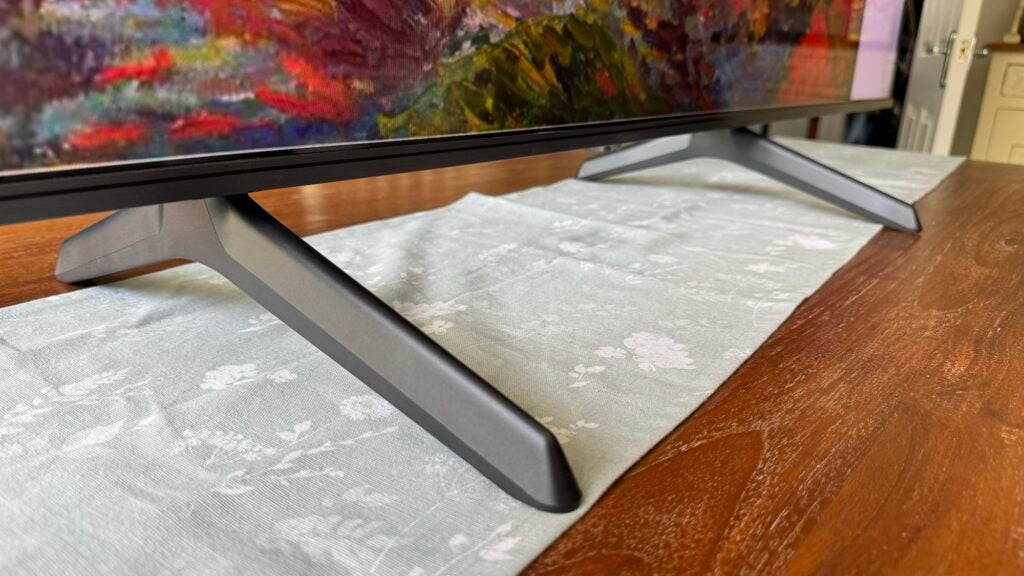
The rear sticks out more than most of today’s high-end TV supermodels too, and while the frame around the screen isn’t exactly chunky, nor can it join some of 2024’s flashest TVs in claiming to be bezel free.
There are a couple of nice design touches, though. First, each bottom corner features a nice grilled design effect that runs a few inches across the bottom edge. Second, Hisense has handily provided two leg attachment position options: either side, with the feet near the TV’s corners, or narrow, where the feet attach just a foot and a half or so apart, so that you can still fit your king-sized new TV onto a fairly small bit of furniture. Provided that small bit of furniture is well made enough to support the TV’s 28.9kg of weight, anyway.
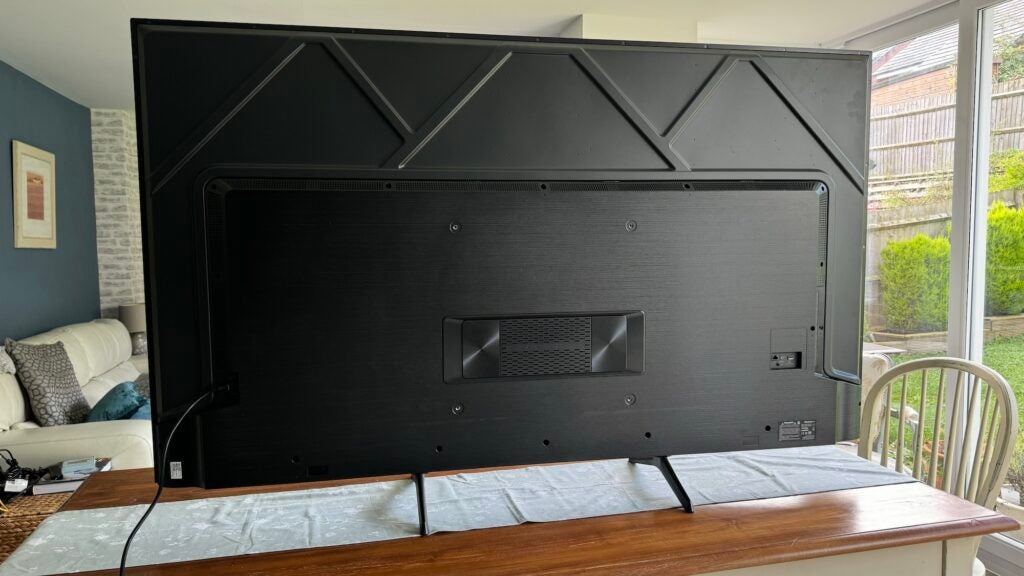
You can also wall mount the TV if you wish. No wall mount is provided, but screw holes are there for third-party mounts using the 400 x 400 VESA fitting standard.
The remote control is as plasticky as the TV, and a bit too heavily loaded with buttons to make it easy to use in a darkened room. On the upside, though, nine of those buttons take you directly to different streaming apps.
Features
- Direct LED lighting with local dimming
- Quantum Dot Colours
- Comprehensive HDR support
The 75E7NQ Pro boasts plenty of promising on-paper goodies. Starting with the fact that its 75-inch 4K screen uses a full array with local dimming lighting system, with its LEDs placed directly behind the screen rather than around its edges. And the zones (I counted 220) of those LEDs can be controlled independently of each other for any given image frame; two attributes that typically contribute to a good contrast performance.
The set also uses Quantum Dots rather than regular RGB filters to deliver its colours, which should yield a much wider and more subtly rendered colour palette. I’m delighted to say that despite its affordability it supports HDR10, HLG, HDR10+ and Dolby Vision.
The panel and its HDMI inputs also support 4K gaming up to frame rates of 144Hz, which is excellent news for this price level, as well as such other key gaming features as variable refresh rates (including AMD Freesync Premium), auto low latency mode switching and a Dolby Vision Game mode so that you can still enjoy fast response times even when gaming in the Dolby Vision format. My tests revealed that the screen is capable of getting input lag – the time it takes to render graphics – down to a very respectable 15.6ms in its Game mode.
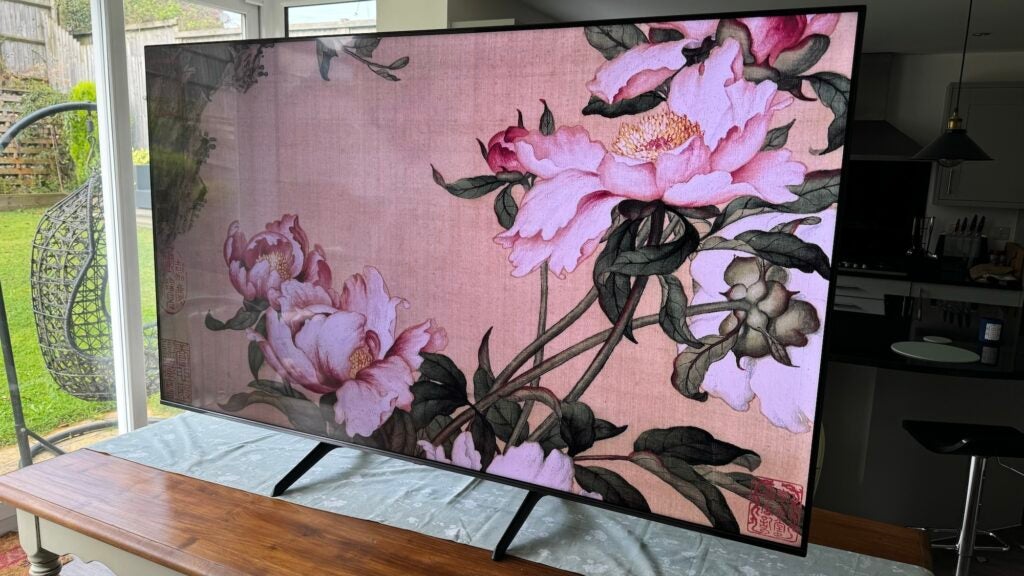
One further handy trick for gamers is the Game Bar. This gaming focused onscreen menu comes up in place of the usual menus when the TV knows you’re playing a game, and provides key info on the gaming signal coming into the TV, as well as direct access to a few helpful gaming aids. Including the facility to boost the brightness of only the dark parts of the picture to help spot lurking enemies.
There is one 75E7NQ Pro specification that raises a potential red flag: its use of an IPS rather than VA type of LCD panel. While IPS panels traditionally support wider viewing angles before losing colour and contrast, they typically struggle to deliver the same sort of contrast that VA types of panel can. A shortcoming that’s traditionally prevented the vast majority of IPS TVs from scoring high picture quality scores. Let’s hope the 75E7NQ Pro is the IPS TV that breaks the mould.
Confusingly not every E7N Pro screen size uses IPS technology. The 100-inch version, which I have also seen and can confirm is excellent for its money, uses a VA panel. As do the 55-inch and 85-inch models. But the 65-inch joins the 75-inch screen in using IPS. While you might therefore take this review’s findings as also broadly applicable to the 65-inch E7N Pro, you shouldn’t consider it a fair reflection of the VA models.
The 75E7NQ Pro’s smart features are delivered by Hisense’s own VIDAA system, backed up by the Freely platform. VIDAA isn’t the most exciting looking interface, but it’s easy to follow, sensibly organised and runs slickly and stably. Plus it covers all the key streaming service bases – Apple TV+, Disney+, YouTube, Netflix, Now, Prime Video and Rakuten have their own dedicated buttons on the 75E7NQ Pro’s remote.
Hisense is one of the first brands to adopt the Freely system in the UK, which enables you to live stream all of the main Freeview channels rather than having to watch them through an aerial. It worked superbly well during my tests, delivering a clean, rich picture across all the channels I tried without any signs of buffering or inconsistency on my 200Mbps broadband service. Even when I moved the TV to the very edge of my Wi-Fi coverage.
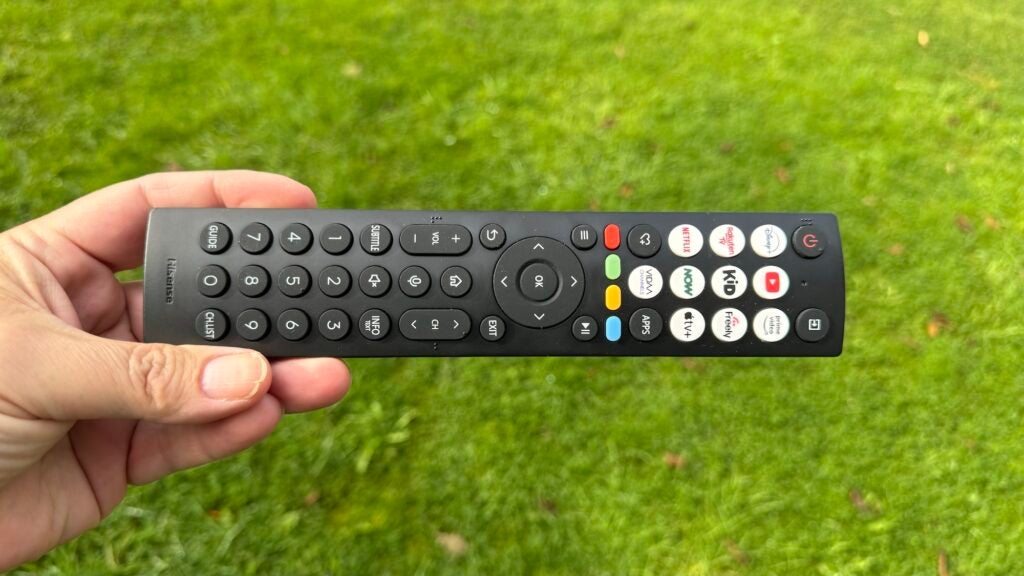
VIDAA supports a decent built-in voice recognition system, too, that helps you skip a few steps of the onscreen menu system once you get used to issuing the right voice commands.
The 75E7NQ Pro’s connectivity is strong for its price point. Two of its four HDMI ports, for instance, are equipped to the full HDMI 2.1 standard, with its support for high 4K frame rates and VRR. There are two USB ports too, one USB 2.0, one USB 3.0, an optical audio output, a 3.5mm audio output, an Ethernet port, the RF input to feed a built-in (in the UK) Freeview tuner, as well as Wi-Fi, Bluetooth 5.2, DLNA and Apple Airplay 2 support.
Picture Quality
- Bold colours and good brightness for the money
- Good sharpness and shadow detail
- Contrast and blooming issues
While the 75E7NQ Pro can look impressive for its money in some settings with specific images, that IPS panel I was worried about does indeed throw a spanner in the works more often than I was comfortable with.
First impressions had me thinking the 75E7NQ Pro may have somehow actually found a way of solving IPS’s traditional contrast and black level issues. Using the Standard picture preset, very dark scenes appeared with surprisingly deep, rich black colours. The local dimming system (which in Standard mode is set to High) does a remarkably good job of managing away the grey wash over dark scenes usually associated with IPS TVs.
What’s more, while the resulting pictures aren’t completely immune to faint details getting crushed out of the picture by the backlight management system, this issue is much less intrusive than I would have expected with an IPS panel that’s working so hard to deliver compelling black levels.
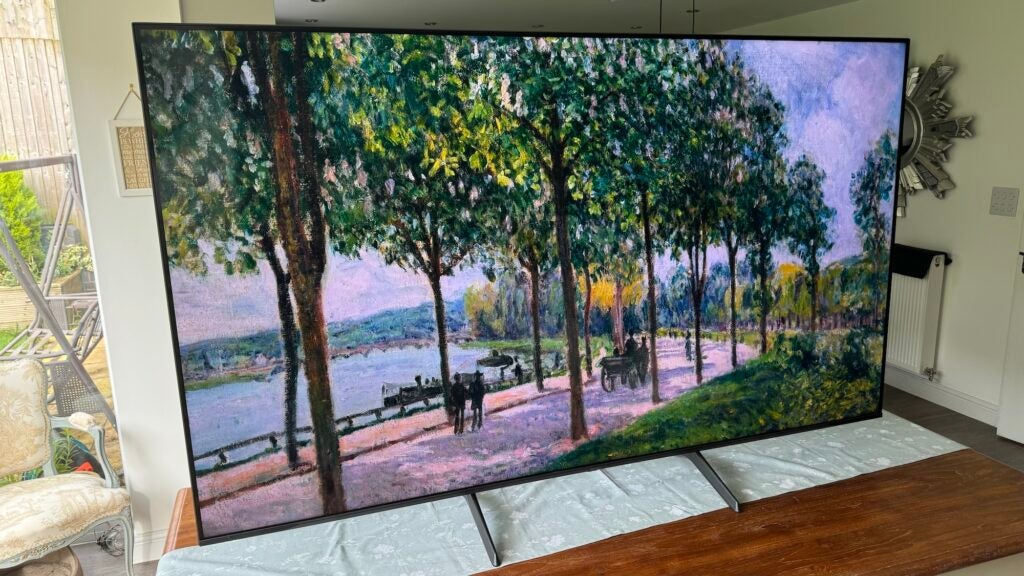
Probably inevitably, though, it turns out that there’s quite a price to pay for the 75E7NQ Pro’s surprisingly decent handling of very dark scenes in the shape of distractingly large and bright amounts of backlight blooming around any bright objects that appear against the screen’s dark areas.
These are especially noticeable when they creep into and move around in the black bars above and below wide aspect ratio films and TV shows, but they can still very clearly appear in the main picture too, creating a cloudy, inconsistent look to darkish sequences that really breaks your immersion in what you’re watching.
The impact of this blooming reduces if you’re watching TV in a fairly bright room. But I’d have thought buyers of a 75-inch TV, even one as affordable as this, would like to enjoy a good movie night with the lights off and the curtains drawn from time to time. And in this set up, the Hisense 75E7NQ Pro just doesn’t deliver the goods as well as many of its current rivals do.
While we’re discussing what I’d consider to be IPS panel effects, I should add that the Hisense 75E7NQ Pro does support slightly wider viewing angles than regular VA panels before colour and contrast take too much of a hit. It’s not a truly massive difference, though, and the blooming issues associated with its local dimming system become exaggerated from even fairly limited viewing angles.
You can reduce the blooming issue by reducing the potency of the local dimming setting from the High level used by default with the Standard picture mode. As soon as you ramp the dimming down from High, though, the panel’s innate light control issues become more pronounced, leaving you with a much greyer, less contrasty picture.
The Filmmaker and Cinema picture modes the Hisense 75E7NQ Pro carries go the route of deactivating or turning down the local dimming, resulting as expected in a more consistent and balanced picture. I was pleasantly surprised, too, by how accurate the Filmmaker mode becomes in terms of SDR greyscale and colour handling. Using Portrait Studios’ Calman Ultimate software, G1 signal generator and C6 HDR colorimeter, I measured the 75E7NQ Pro as achieving DeltaE 2000 errors in SDR Filmmaker mode of just 3.3 and 1.9 for Multipoint grayscale and Saturation Sweep tests respectively – where a measurement of three or less means the human eye won’t be able to see the issue.
The black level problems that accompany the greyscale and colour accuracy, though, mean that Filmmaker mode doesn’t ultimately feel nearly as accurate as the measurements suggest. The mode also lacks depth thanks both to the flattening effect of the set’s uninspiring native black levels, and the way the Filmmaker mode turns off Hisense’s Dynamic Tone Mapping feature, which injects more intensity into bright HDR picture areas by mapping HDR signals onto the extremes of the screen’s capabilities.
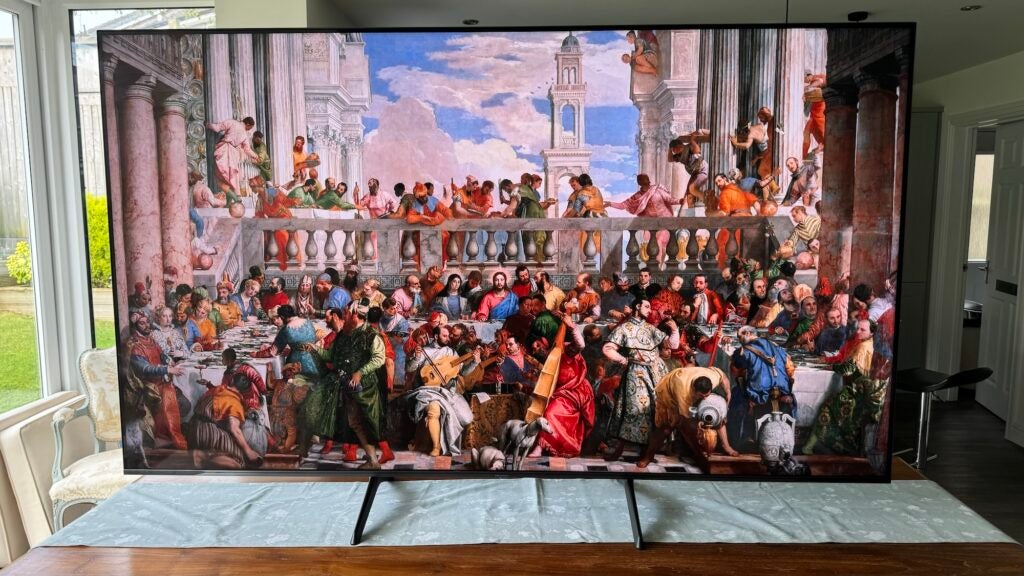
Dynamic Tone Mapping is in play by default with the Standard preset, and joins forces with the High local dimming setting to deliver a punchier, more dynamic picture that actually feels much better suited to the screen’s abilities than the more measurably accurate picture modes.
The Dynamic Tone Mapping can sometimes cause a bleached out effect in areas of really extreme brightness, making me wish Hisense had provided a little control over how aggressively the tone mapping is applied. But this clipping is rare enough not to rate as a really serious problem.
Calman Ultimate tests reveal that the 75E7NQ Pro isn’t particularly bright for a modern big-screen TV. It peaks at around 640 nits on a 25% HDR window, and around 580 nits on a 10% HDR window. Strangely, though, the brightness actually feels higher than that – maybe because of the sheer size of the screen it’s appearing on, and/or because it retains much of that brightness (480 nits measured on a 100% white HDR window) with full-screen bright HDR content.
The 75E7NQ Pro also impresses for its money, at least in its Standard preset, with the punch and vibrancy of its colours. Tones across the board really pop off the screen without tipping over into gaudiness or distracting imbalances.
There’s not quite as much finesse and insight to tones in Standard mode as I’d ideally like to see, leaving a marginally coarse feel to the image and some occasionally plasticky or patchy skin tones. The boldness of the presentation is striking enough for the £1,299 price point, though, that a lack of insight versus the best premium TVs is easy enough to forgive.
The boldness of the 75E7NQ Pro’s colours does come at the expense of accuracy. But given how flat the set’s accurate images look because of the reduction in contrast and light control required to achieve that accuracy, I personally found the Standard mode’s more aggressive approach much more satisfying.
More contributions to what can be a quite likeable picture on the 75E7NQ Pro find the overall brightness level not suffering with any delayed ‘jumping’ as a scene cuts between dark and light shots, and a smaller desaturation of colours in dark scenes than I often see with such relatively affordable screens.
Finally, while the 75E7NQ Pro’s handling of motion with 24 frames a second content isn’t quite as good as it is with more premium Hisense sets, its motion still looks decently convincing for for a £1299 75-inch TV.
Sound Quality
- Built in subwoofer
- 2 x 15W plus 20W to the subwoofer
- Small forward firing speaker outlets
The inclusion of a substantial bass speaker on the Hisense 75E7NQ Pro’s rear and a total of 50W of available speaker power raises hopes of an unusually potent sound system – and to some extent, at least, Hisense’s screen delivers on these hopes.
Volume levels can get seriously loud, and while the sound doesn’t project very far beyond the screen’s edges, it does at least have enough scale to appear to be coming from the whole screen area – including from top to bottom as well as side to side with Dolby Atmos mixes. All while voices remain locked at the heart of the screen.
The loudness doesn’t readily give in to distortions, either, and it’s got enough headroom and dynamic range to keep expanding its output to keep up with escalating action sequences.
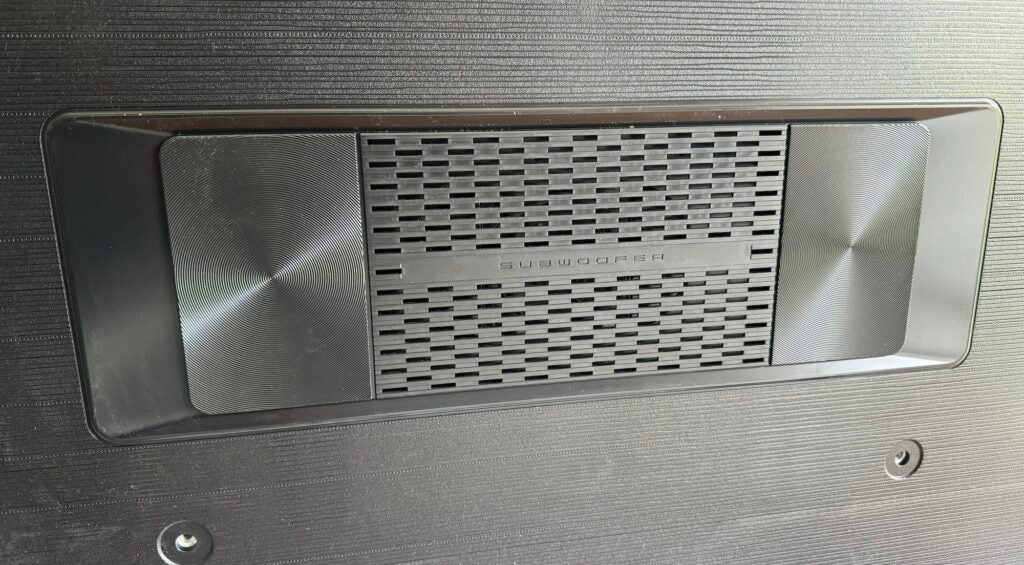
The bass output from that substantial rear-mounted subwoofer is impressive too, not only for how low it manages to get, but also for how little it distorts even under such pressure. It’s likeably eager to get involved in the mix, too.
The sound does all seem to be emanating from slightly behind the screen, denying it some immediacy and force, and voices can take on a slightly echoey feel if you haven’t got the TV positioned quite close to a wall. The sound can become pretty harsh and condensed in the treble register under pressure too, at least at high volumes – something which also leads to some over-emphasis of ambient effects.
In the context of the Hisense 75E7N Pro’s aggressive price, though, its sound can overall be considered above par.
Latest deals
Should you buy it?
An inexpensive big screen telly
You want a big, colourful 4K screen with plenty of game features that doesn’t cost the earth.
You want a cinematic experience
You want to use your TV to watch films in dark room settings.
Final Thoughts
The Hisense 75E7N Pro sounds pretty good, has strong streaming and gaming support, and can deliver pictures capable of looking pretty enjoyable in its Standard preset with relatively undemanding or consistently bright content.
For many of the sort of home cinema fans likely to be in the market for such a big-screen TV, though, the struggles this one has handling dark images, especially in dark rooms, may well be too bitter a pill to swallow.
How we test
We test every television we review thoroughly over an extended period of time. We use industry standard tests to compare features properly. We’ll always tell you what we find. We never, ever, accept money to review a product.
Find out more about how we test in our ethics policy.
This TV was tested over a period of three weeks.
Subjective viewing was done with day to day TV, 4K Blu-rays and multiple streaming services.
Objective testing took place using Portrait Displays’ Calman Ultimate analysis and calibration software, G1 signal generator and C6 colorimeter.
FAQs
It uses an IPS panel illuminated by direct LED lighting driven by a local dimming system.
QLED TVs such as the Hisense 75E7N Pro use technology called Quantum Dots to produce their colours rather than RGB Filters. Resulting in a wider colour range and usually brighter pictures.
The 75E7N Pro uses Hisense’s own VIDAA smart system – complete with voice recognition and control.







